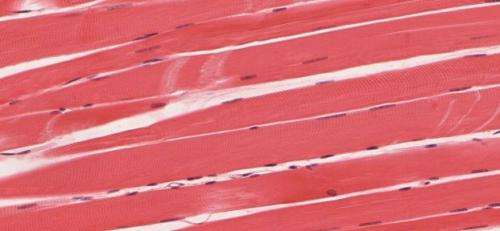Muscle stem cells compiled in 'atlas'

Muscle repair is a crowded, complicated business. Many different types of cells are bumping around, chattering and trying to coordinate with each other as they work to regenerate new tissue.
A team of Cornell researchers led by Ben Cosgrove, assistant professor in the Meinig School of Biomedical Engineering, used a new cellular profiling technology to probe and catalog the activity of almost every kind of cell involved in muscle repair. They compiled their findings into a "cell atlas" of muscle regeneration that is one of the largest datasets of its kind. This resource provides a comprehensive picture of the many intricate cellular interactions in tissue self-repair and may potentially lead to better rehabilitation strategies and support for patients recovering from muscle injuries.
The team's paper, "Single-Cell Analysis of the Muscle Stem Cell Hierarchy Identifies Heterotypic Communication Signals Involved in Skeletal Muscle Regeneration," published March 10 in Cell Reports.
Cosgrove worked with Cornell's Biotechnology Resource Center to use single-cell RNA sequencing to analyze the gene expression signatures in thousands of individual cells, all taken from the actively regenerating muscles of mice—including the rare muscle stem cells that drive the repair process. Cosgrove also collaborated with Iwijn De Vlaminck, the Robert N. Noyce Assistant Professor in Life Science and Technology in the Meinig School of Biomedical Engineering. Together, they applied new algorithms to filter the extensive collection of molecular information.
The researchers profiled and collected approximately 35,000 individual cells. The resulting atlas is a benchmark technical resource for researchers studying skeletal muscle tissue.
"Because we have such a large dataset, it helps us frame a number of hypothesis-driven questions about not only which cells are involved, but how they are communicating with each other," said Cosgrove. "This resource enabled us to ask 'What molecular signals are one type of cells sending to the other cells within the process of muscle repair?'"
Unlike a road atlas that uses spatial coordinates, this atlas is more of a "laundry list of the key cell players," Cosgrove said, itemizing their similarities and differences, with 15 unique cell types in muscle tissue. This collection emphasizes how much heterogeneity exists within each cell type, a range of diversity that led the researchers to pursue the sources of specific molecular variations that might be otherwise overlooked.
"Because this approach allows us to look closely at one cell at a time, we could consider and evaluate the subtle differences even within a similar group of the same cells," he said.
Cosgrove's lab has already put the atlas to good use by identifying how a class of proteins called syndecans play a pivotal role in enabling muscle stem cells to make a binary choice during the process of muscle regeneration. As they are dividing, the stem cells chose either to replenish the stem cell population, or they turn into the mature myofiber cells that replace damaged muscle tissue.
"We took this huge atlas and partitioned it down to the stem cells. And then we organized the stem cells in a way that gives us a framework to think about variation and the choices the cells are making," Cosgrove said.
Their findings show that syndecan-related variations may help direct how muscle stem cells respond to signals from their neighboring cells and which outcome they chose.
"Now that we know more about what is happening in the healthy, normal adult repair process, we can ask 'How do the cellular players get misallocated and misactivated in the disease settings?'" Cosgrove said.
Cosgrove's group is currently applying this approach to look at muscle repair deficiency in aging and muscular dystrophy.
More information: Andrea J. De Micheli et al, Single-Cell Analysis of the Muscle Stem Cell Hierarchy Identifies Heterotypic Communication Signals Involved in Skeletal Muscle Regeneration, Cell Reports (2020). DOI: 10.1016/j.celrep.2020.02.067



















